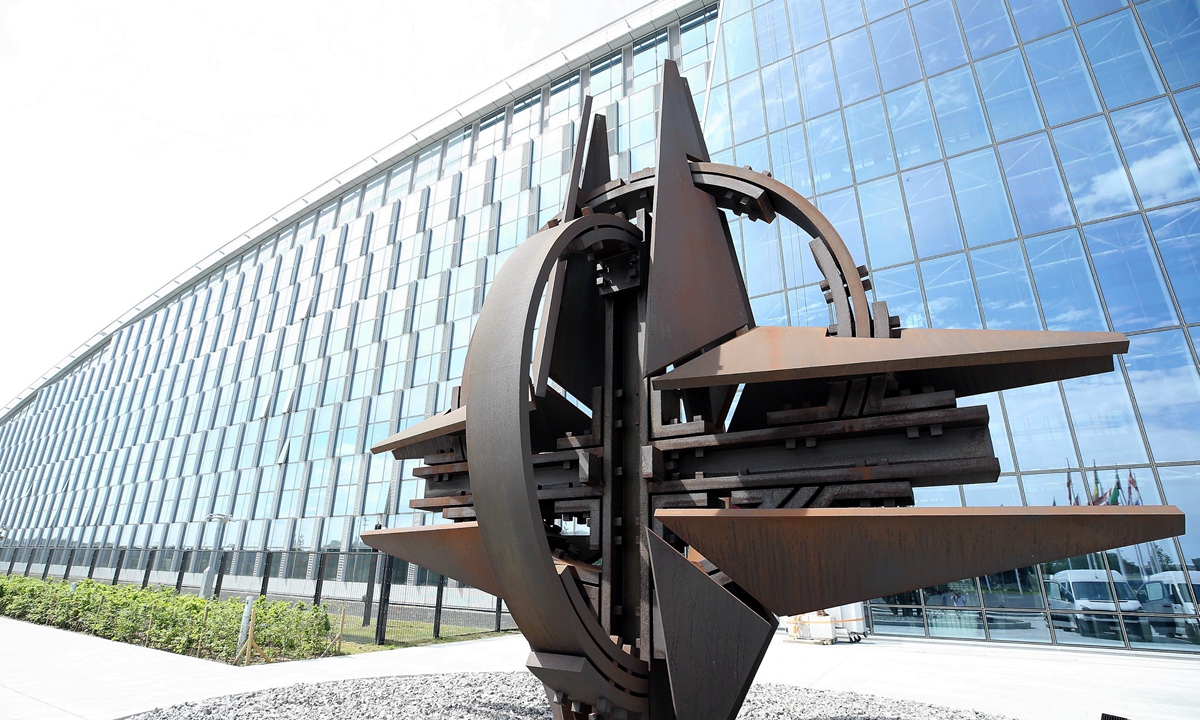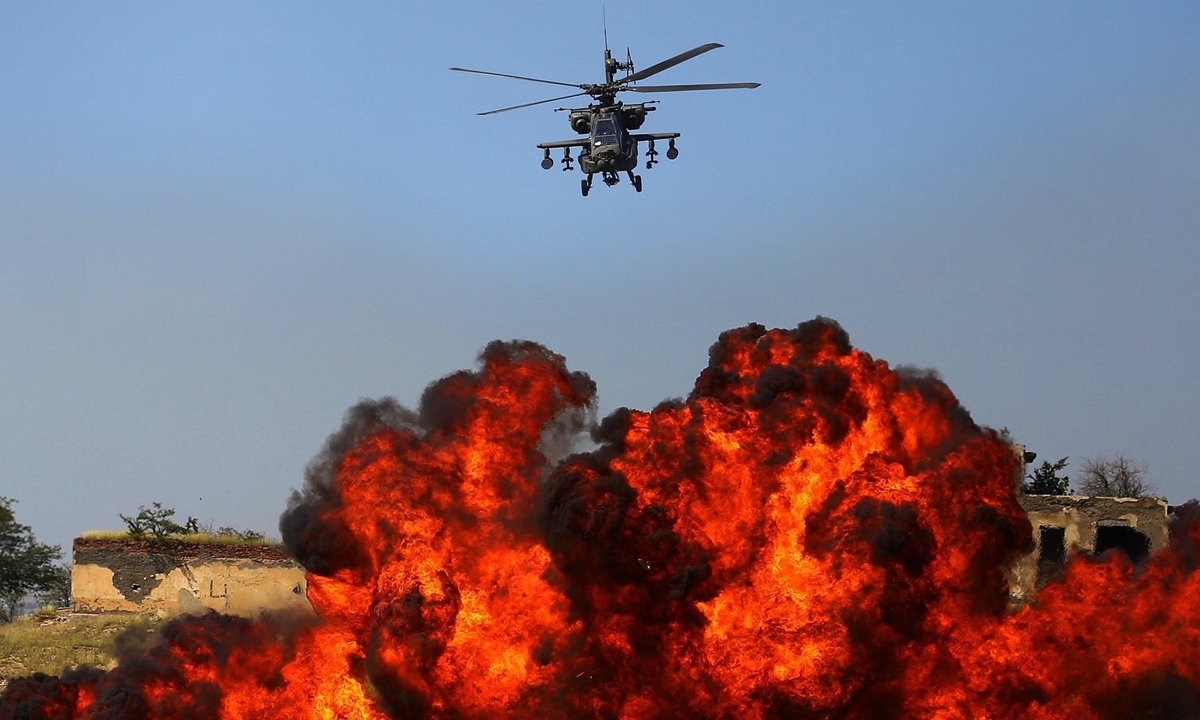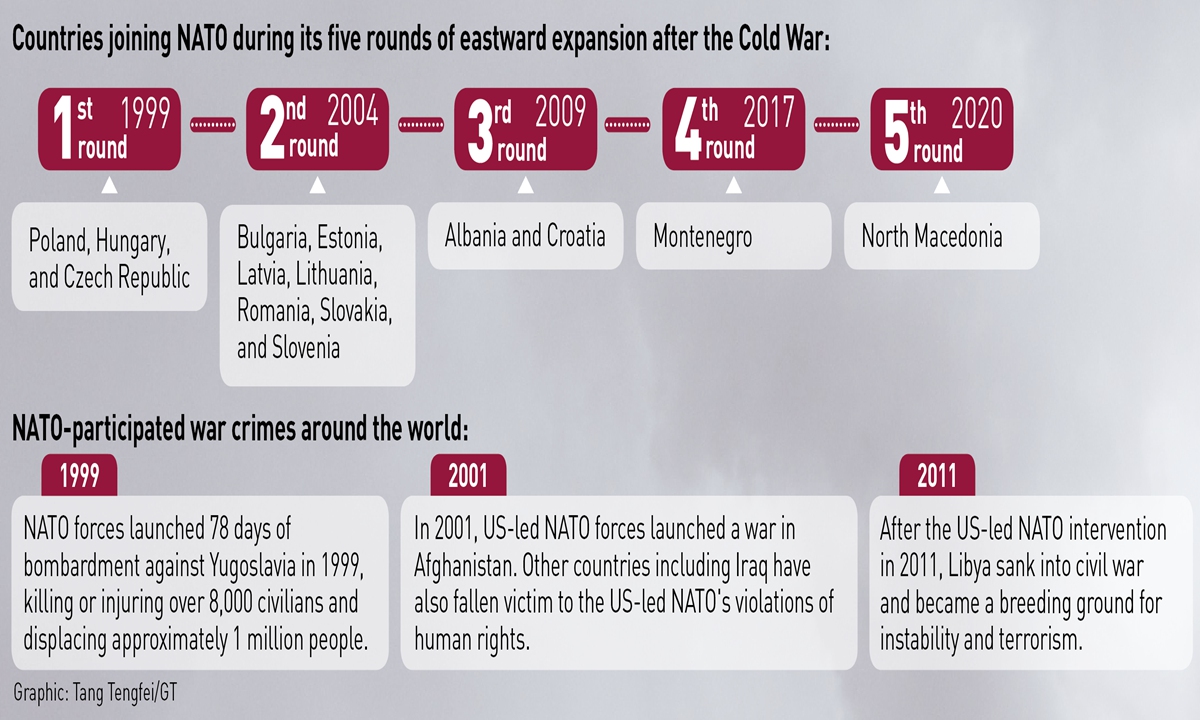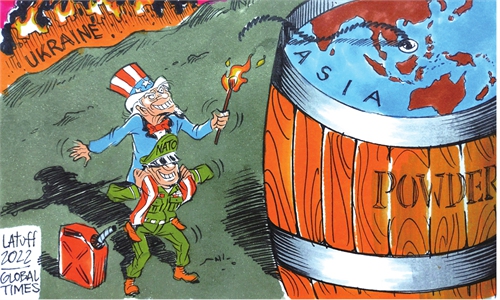IN-DEPTH / IN-DEPTH
How NATO began with confrontation and ends with poisoning world peace?
Western war machine
Editor's Note:
Amid the still ongoing Russia-Ukraine military conflict, NATO, which has been adding fuel to the conflict, started a three-day summit in Madrid, Spain, from June 28 to 30. The NATO alliance works to increase pressure on Russia over its conflict with Ukraine while underscoring their continued concerns about China. For the first time in history, leaders from four Asia-Pacific countries - namely Australia, Japan, South Korea, and New Zealand - were also invited to attend the NATO summit. The militant group which has already made troubles for Europe is now trying to create its own Asia-Pacific chapter to interfere in Asia. How did the organization come about? How was it born from the Cold War mentality and gradually became a poisoner of world peace? Why is this military alliance extending its "dark hand" to Asia? The Global Times will publish a series of four articles on how NATO is expanding. This is the first installment.

If the USSR - better known as the Soviet Union - were considered to be included in NATO, the organization of a military alliance "would cease to be a closed military alignment of states and would be open to other European countries which, together with the creation of an effective system of European collective security, would be of cardinal importance for the promotion of universal peace."
This was what the Soviet Union said in the diplomatic note the country issued on March 31, 1954 to Western powers stating its willingness to have considered joining NATO.
Unsurprisingly, the Soviet Union was rejected.
What's more, British general Hastings Ismay, then NATO's secretary general, opposed in May 1954 the request made by the Soviet Union, saying that "the Soviet request to join NATO is like an unrepentant burglar requesting to join the police force." Ismay thus made it apparent that the NATO alliance was directed against the Soviet Union. In May 1955, over the objections of the Soviet Union, NATO brought into its fold West Germany, which the Soviet Union saw as a buffer zone. In response, soon afterward, the Soviet-led Warsaw Pact was formed, setting the stage for a confrontation between the world's two largest military blocs during the entire Cold War era.
A military clique born of a confrontation mind-set
NATO's origins lay mainly in the inherent hostility of Western capitalist nations, with the US and the UK at its core, to the world communist movement, as well as in the so-called Red Scare - the West's fear of the Soviet Union's power during World War II.
On March 5, 1946, in one of the most famous orations of the Cold War period, former British prime minister Winston Churchill condemned the Soviet Union's policies in Europe and declared, "From Stettin in the Baltic to Trieste in the Adriatic, an iron curtain has descended across the continent." Churchill's speech is considered one of the opening salvoes announcing the beginning of the Cold War.
In the founding of NATO, if the Iron Curtain speech was a passing attack before a goal was scored, the final kick was the Truman Doctrine. On March 12, 1947, one year after the Iron Curtain address, then US president Harry Truman delivered a speech to a joint session of US Congress, in which he devided the world into two camps: "liberal democracy" and "totalitarian communism." In response to what he called the "threat" from the Soviet Union, he said actions must be taken to intervene and contain it, which came to be known as the Truman Doctrine.
Starting from the Truman Doctrine, the US pursued the "Marshall Plan" in foreign economic policy and led the entrenchment of NATO in military and security policy. The Truman Doctrine was regarded as the "starting point" for the NATO mechanism and the Cold War trigger, by shifting from traditional policy from the Roosevelt era, which regarded the Soviet Union as an ally, to a policy aimed at containing the Soviet Union.
On April 4, 1949, the US and 11 other countries jointly signed the North Atlantic Treaty in Washington, and NATO - North Atlantic Treaty Organization - was officially established. The principle of collective defense is at the very heart of NATO's founding treaty and is enshrined in Article 5 of the Washington Treaty. Collective defense means that an attack against one ally is considered an attack against all allies.
Looking back on the founding of NATO, it is not hard to see that from the very beginning, the organization was formed in the Cold War era as a clique engaged in bloc confrontation and military threat. NATO, which was born out of this mind-set, built a grotesque Iron Curtain during the Cold War era.

To confront the Soviet Union and control Europe
NATO's mode of conduct has a lot to do with the personalities of its military chiefs.
Ismay, NATO's first secretary general, was remembered primarily for his role as former British prime minister Winston Churchill's chief military assistant during WWII. In that capacity, Ismay served as the principal link between Churchill and the Chiefs of Staff Committee. Having brought down the "Iron Curtain" of the Cold War, Churchill recommended his right-hand man as the NATO secretary-general and put him at the forefront of the Cold War.
As the first NATO secretary general, Ismay was "assuming an entirely new role in the history of international organizations," and as such he helped to define the position itself. While in the post, Ismay was also credited as having been the first person to say that the purpose of NATO was "to keep the Russians out, the Americans in, and the Germans down," a line that has since become shorthand meant to describe the alliance.
The saying inherited and "carried forward" the UK's centuries-old policy of balancing of power - using NATO to fight the Soviet Union on the one hand, and using the US to hold down the continental challenger, Germany, on the other.
Under Ismay's motivation, the US and the UK reached a consensus to use NATO to control the European continent and to compete against the Soviet Union. Ismay once said that the NATO "must grow until the whole free world gets under one umbrella."
Enlarging and setting fires
After the establishment of NATO and in the face of increasing pressure from this organization, Eastern European socialist countries headed by the Soviet Union signed the Warsaw Pact in 1955.
Notably, the treaty was valid for only 20 years. In 1975, when the Warsaw Pact expired, the member states issued a statement reaffirming their willingness to not dissolve until NATO was disbanded.
There is no doubt that such a statement is just a dream. NATO continued to exist, and the Warsaw Pact could not be dissolved. So the validity of the Warsaw Pact kept getting extended from 1975, until March 31, 1991, when the Warsaw Pact announced its dissolution after the disintegration of the Soviet Union.
However, as a product of the Cold War, not only has NATO not withdrawn from the stage of history following the end of the Cold War, but instead it has continued to expand and grow. In order to justify its continued existence following the end of the Cold War, NATO updated its strategic concept many times over the decades since the demise of the Warsaw Pact, and the topics involved have also expanded from confronting military threats in the past to responding to terrorism and international and regional crises.
In 1999, NATO absorbed Poland, Hungary and the Czech Republic - three former Warsaw Pact members - as its official members, breaking the long-term stable geostrategic pattern after WWII, and casting a shadow over the multipolar trend that emerged after the Cold War. Since then, NATO has expanded eastward five times, and its member countries have increased from the original 12 in 1949 to the 16 in 1999 to the current 30.
In the process of its expansion, NATO has also been "moving forward" toward Russia, reaching Russia's extremely sensitive "homeland in history," - Ukraine - also known as the "heel of the Russian Empire" in Napoleon's eyes.
Facing the looming squeeze, in December 2021, the Russian government was forced to draw its final "red line" in a draft security initiative submitted to NATO and the US. But since the disintegration of the Soviet Union, the security concerns of Russia, which lost its hegemonic status, have never been a concern in the eyes of the US and NATO. The West has not only brutally rejected Russia's draft security initiative, but also fanned the flames between Russia and Ukraine, leading to a military conflict between the two countries with deep historical ties. At present, tens of millions of people in Ukraine have been forced to leave their homeland, and the global economy has suffered as a result.
In addition to keeping a close eye on Russia's every step, NATO also, in the name of safeguarding "democracy, freedom, and human rights," has extended its dark hand of military intervention to the Middle East, Africa, and other regions, causing many countries to descend into war.
In 1999, NATO launched an attack against Russia's traditional ally, Yugoslavia. In 2001, NATO, led by the US, launched a war in Afghanistan. After the Iraq and Libya wars broke out one after another, NATO had been "killing and setting fires" across the world, while the people in the invaded countries wept and mourned on the ruins of once-prosperous societies.
The actions of NATO over the past decades have proven that its character, as engraved on its bones, cannot be changed, that is to despise the international system upheld by the UN at the core and the international order based on international law, turn international relations into camps, military blocs, and pan-nationalist ideology, poison regional and world peace and stability.

Heading Asia-Pacific
It is worth noting that in the process of NATO's expansion, it has become more than just a military alliance. It is also a tool for Western countries to promote their "values" and for the US to seek global hegemony.
While taking advantage of the Russia-Ukraine conflict to enhance cohesion in Europe, NATO has also accelerated its "Asia-Pacific" process.
In the NATO 2030 agenda, NATO has clearly identified Japan, South Korea, New Zealand and Australia as its four major partner countries in the Asia-Pacific region.
On May 5, 2022, South Korea announced its participation in the NATO Cooperative Cyber Defence Centre of Excellence, becoming the first Asian country to join the organization, the Korea Herald reported. On May 16, Koji Yamazaki, chief of staff, joint staff of Japan's Self-Defense Forces, attended the NATO Military Chiefs of Defense meeting for the first time, the Nikkei reported.
Where is NATO heading? Julianne Smith, the US Ambassador to NATO, revealed on June 1 that NATO plans to adopt a "new strategic concept" at the ongoing Madrid summit, which will list Russia as "NATO's top priority" and will include China as well.
NATO leaders attending the meeting in Madrid should not forget that the two world wars, the Cold War between the US and the Soviet Union, and the ongoing conflict between Russia and Ukraine have all proven with bloody facts that the Cold War mentality will only damage the global peace framework. Hegemonism and power politics will only endanger world peace, and a group confrontation will only exacerbate global security challenges.
As the team leader of NATO, the US has been trying to transform NATO from a US strategic geopolitical tool in Europe to its global strategic geopolitical tool in recent years.
Wherever NATO's "dark hand" reaches, people there are irrevocably alerted. The "alliance" that is based on political groups and camp confrontations, and the "security" that is based on others' "insecurity," are like a house built on sand - it will ultimately collapse.
Amid the still ongoing Russia-Ukraine military conflict, NATO, which has been adding fuel to the conflict, started a three-day summit in Madrid, Spain, from June 28 to 30. The NATO alliance works to increase pressure on Russia over its conflict with Ukraine while underscoring their continued concerns about China. For the first time in history, leaders from four Asia-Pacific countries - namely Australia, Japan, South Korea, and New Zealand - were also invited to attend the NATO summit. The militant group which has already made troubles for Europe is now trying to create its own Asia-Pacific chapter to interfere in Asia. How did the organization come about? How was it born from the Cold War mentality and gradually became a poisoner of world peace? Why is this military alliance extending its "dark hand" to Asia? The Global Times will publish a series of four articles on how NATO is expanding. This is the first installment.

An external view of NATO's headquarters in Brussels, Belgium Photo: VCG
If the USSR - better known as the Soviet Union - were considered to be included in NATO, the organization of a military alliance "would cease to be a closed military alignment of states and would be open to other European countries which, together with the creation of an effective system of European collective security, would be of cardinal importance for the promotion of universal peace."
This was what the Soviet Union said in the diplomatic note the country issued on March 31, 1954 to Western powers stating its willingness to have considered joining NATO.
Unsurprisingly, the Soviet Union was rejected.
What's more, British general Hastings Ismay, then NATO's secretary general, opposed in May 1954 the request made by the Soviet Union, saying that "the Soviet request to join NATO is like an unrepentant burglar requesting to join the police force." Ismay thus made it apparent that the NATO alliance was directed against the Soviet Union. In May 1955, over the objections of the Soviet Union, NATO brought into its fold West Germany, which the Soviet Union saw as a buffer zone. In response, soon afterward, the Soviet-led Warsaw Pact was formed, setting the stage for a confrontation between the world's two largest military blocs during the entire Cold War era.
A military clique born of a confrontation mind-set
NATO's origins lay mainly in the inherent hostility of Western capitalist nations, with the US and the UK at its core, to the world communist movement, as well as in the so-called Red Scare - the West's fear of the Soviet Union's power during World War II.
On March 5, 1946, in one of the most famous orations of the Cold War period, former British prime minister Winston Churchill condemned the Soviet Union's policies in Europe and declared, "From Stettin in the Baltic to Trieste in the Adriatic, an iron curtain has descended across the continent." Churchill's speech is considered one of the opening salvoes announcing the beginning of the Cold War.
In the founding of NATO, if the Iron Curtain speech was a passing attack before a goal was scored, the final kick was the Truman Doctrine. On March 12, 1947, one year after the Iron Curtain address, then US president Harry Truman delivered a speech to a joint session of US Congress, in which he devided the world into two camps: "liberal democracy" and "totalitarian communism." In response to what he called the "threat" from the Soviet Union, he said actions must be taken to intervene and contain it, which came to be known as the Truman Doctrine.
Starting from the Truman Doctrine, the US pursued the "Marshall Plan" in foreign economic policy and led the entrenchment of NATO in military and security policy. The Truman Doctrine was regarded as the "starting point" for the NATO mechanism and the Cold War trigger, by shifting from traditional policy from the Roosevelt era, which regarded the Soviet Union as an ally, to a policy aimed at containing the Soviet Union.
On April 4, 1949, the US and 11 other countries jointly signed the North Atlantic Treaty in Washington, and NATO - North Atlantic Treaty Organization - was officially established. The principle of collective defense is at the very heart of NATO's founding treaty and is enshrined in Article 5 of the Washington Treaty. Collective defense means that an attack against one ally is considered an attack against all allies.
Looking back on the founding of NATO, it is not hard to see that from the very beginning, the organization was formed in the Cold War era as a clique engaged in bloc confrontation and military threat. NATO, which was born out of this mind-set, built a grotesque Iron Curtain during the Cold War era.

A helicopter is seen during the closing ceremony of the Multinational Exercise Noble Partner 2020 in Tbilisi, Georgia on September 18, 2020. About 2,700 military personnel from Georgia and other NATO members take part in the exercise. Photo: VCG
To confront the Soviet Union and control Europe
NATO's mode of conduct has a lot to do with the personalities of its military chiefs.
Ismay, NATO's first secretary general, was remembered primarily for his role as former British prime minister Winston Churchill's chief military assistant during WWII. In that capacity, Ismay served as the principal link between Churchill and the Chiefs of Staff Committee. Having brought down the "Iron Curtain" of the Cold War, Churchill recommended his right-hand man as the NATO secretary-general and put him at the forefront of the Cold War.
As the first NATO secretary general, Ismay was "assuming an entirely new role in the history of international organizations," and as such he helped to define the position itself. While in the post, Ismay was also credited as having been the first person to say that the purpose of NATO was "to keep the Russians out, the Americans in, and the Germans down," a line that has since become shorthand meant to describe the alliance.
The saying inherited and "carried forward" the UK's centuries-old policy of balancing of power - using NATO to fight the Soviet Union on the one hand, and using the US to hold down the continental challenger, Germany, on the other.
Under Ismay's motivation, the US and the UK reached a consensus to use NATO to control the European continent and to compete against the Soviet Union. Ismay once said that the NATO "must grow until the whole free world gets under one umbrella."
Enlarging and setting fires
After the establishment of NATO and in the face of increasing pressure from this organization, Eastern European socialist countries headed by the Soviet Union signed the Warsaw Pact in 1955.
Notably, the treaty was valid for only 20 years. In 1975, when the Warsaw Pact expired, the member states issued a statement reaffirming their willingness to not dissolve until NATO was disbanded.
There is no doubt that such a statement is just a dream. NATO continued to exist, and the Warsaw Pact could not be dissolved. So the validity of the Warsaw Pact kept getting extended from 1975, until March 31, 1991, when the Warsaw Pact announced its dissolution after the disintegration of the Soviet Union.
However, as a product of the Cold War, not only has NATO not withdrawn from the stage of history following the end of the Cold War, but instead it has continued to expand and grow. In order to justify its continued existence following the end of the Cold War, NATO updated its strategic concept many times over the decades since the demise of the Warsaw Pact, and the topics involved have also expanded from confronting military threats in the past to responding to terrorism and international and regional crises.
In 1999, NATO absorbed Poland, Hungary and the Czech Republic - three former Warsaw Pact members - as its official members, breaking the long-term stable geostrategic pattern after WWII, and casting a shadow over the multipolar trend that emerged after the Cold War. Since then, NATO has expanded eastward five times, and its member countries have increased from the original 12 in 1949 to the 16 in 1999 to the current 30.
In the process of its expansion, NATO has also been "moving forward" toward Russia, reaching Russia's extremely sensitive "homeland in history," - Ukraine - also known as the "heel of the Russian Empire" in Napoleon's eyes.
Facing the looming squeeze, in December 2021, the Russian government was forced to draw its final "red line" in a draft security initiative submitted to NATO and the US. But since the disintegration of the Soviet Union, the security concerns of Russia, which lost its hegemonic status, have never been a concern in the eyes of the US and NATO. The West has not only brutally rejected Russia's draft security initiative, but also fanned the flames between Russia and Ukraine, leading to a military conflict between the two countries with deep historical ties. At present, tens of millions of people in Ukraine have been forced to leave their homeland, and the global economy has suffered as a result.
In addition to keeping a close eye on Russia's every step, NATO also, in the name of safeguarding "democracy, freedom, and human rights," has extended its dark hand of military intervention to the Middle East, Africa, and other regions, causing many countries to descend into war.
In 1999, NATO launched an attack against Russia's traditional ally, Yugoslavia. In 2001, NATO, led by the US, launched a war in Afghanistan. After the Iraq and Libya wars broke out one after another, NATO had been "killing and setting fires" across the world, while the people in the invaded countries wept and mourned on the ruins of once-prosperous societies.
The actions of NATO over the past decades have proven that its character, as engraved on its bones, cannot be changed, that is to despise the international system upheld by the UN at the core and the international order based on international law, turn international relations into camps, military blocs, and pan-nationalist ideology, poison regional and world peace and stability.

Graphic: Tang Tengfei/GT
Heading Asia-Pacific
It is worth noting that in the process of NATO's expansion, it has become more than just a military alliance. It is also a tool for Western countries to promote their "values" and for the US to seek global hegemony.
While taking advantage of the Russia-Ukraine conflict to enhance cohesion in Europe, NATO has also accelerated its "Asia-Pacific" process.
In the NATO 2030 agenda, NATO has clearly identified Japan, South Korea, New Zealand and Australia as its four major partner countries in the Asia-Pacific region.
On May 5, 2022, South Korea announced its participation in the NATO Cooperative Cyber Defence Centre of Excellence, becoming the first Asian country to join the organization, the Korea Herald reported. On May 16, Koji Yamazaki, chief of staff, joint staff of Japan's Self-Defense Forces, attended the NATO Military Chiefs of Defense meeting for the first time, the Nikkei reported.
Where is NATO heading? Julianne Smith, the US Ambassador to NATO, revealed on June 1 that NATO plans to adopt a "new strategic concept" at the ongoing Madrid summit, which will list Russia as "NATO's top priority" and will include China as well.
NATO leaders attending the meeting in Madrid should not forget that the two world wars, the Cold War between the US and the Soviet Union, and the ongoing conflict between Russia and Ukraine have all proven with bloody facts that the Cold War mentality will only damage the global peace framework. Hegemonism and power politics will only endanger world peace, and a group confrontation will only exacerbate global security challenges.
As the team leader of NATO, the US has been trying to transform NATO from a US strategic geopolitical tool in Europe to its global strategic geopolitical tool in recent years.
Wherever NATO's "dark hand" reaches, people there are irrevocably alerted. The "alliance" that is based on political groups and camp confrontations, and the "security" that is based on others' "insecurity," are like a house built on sand - it will ultimately collapse.

